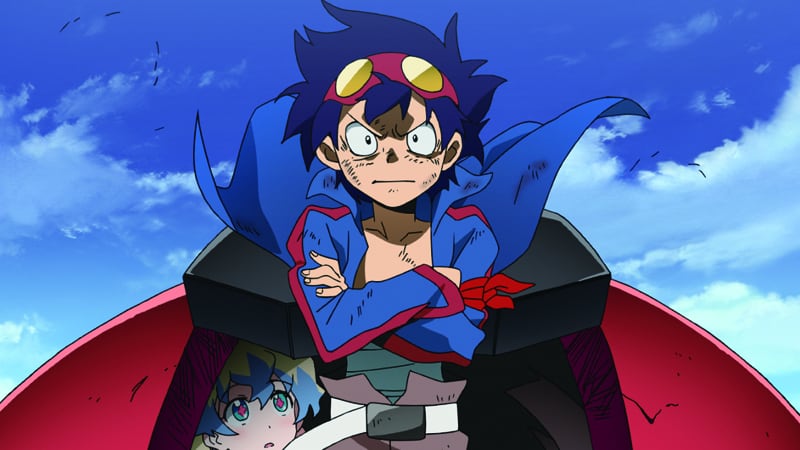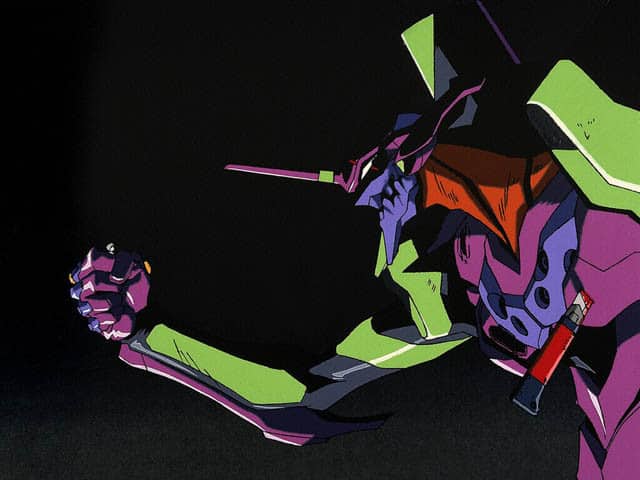
For more in this series, check out our Anime archives.
Out of all the mecha anime out there, Neon Genesis Evangelion has stood the test of time as one of the best. It explores realistic psychological themes, and its subsequent cult following is constantly reading into its deeper ideas about depression and Christo-Judaean imagery. But while many argue that Evangelion is the definitive work of Studio Gainax, it is their 2007 mecha anime, Tengen Toppa Gurren Lagann, that shows the full potential of what the studio could make in its heyday.
There’s no denying that Evangelion is a masterpiece. But it is a masterpiece with a deeply troubled production history. For all the discussion on Evangelion and the deep psychological meaning of its ending, the truth of the matter is that by the time the ending of the series reared its terrifying robot head, the production had run out of money. Beyond this, director Hideaki Anno was known for running very close to deadlines throughout Evangelion‘s entire original TV run and suffered from depression throughout.

Evangelion would get a second chance with 2007’s Rebuild of Evangelion announcement, a film series reboot of the show. But at the same time, Studio Gainax began release of Tengen Toppa Gurren Lagann, directed by Hiroyuki Imaishi and written by Kazuki Nakashimi, who cited Evangelion itself as one of his biggest influences in the former’s creation.
Tengen Toppa Gurren Lagann can be viewed almost as a companion piece or counterpoint to Evangelion. While both anime feature giant fighting robots prominently, their approach to the genre is nearly opposing. The protagonist of Tengen Toppa Gurren Lagann, a boy named Shimon, begins the series as a meek and insecure youth, like Evangelion’s Shinji Ikari, but quickly matures into a confident and capable pilot who leads the show’s ensemble cast to victory over a ruling overlord. Then, after seven years of peace, space aliens appear out of nowhere, and Shimon must once again take up the mecha pilot’s literal starter key to defeat the invaders and bring peace to the galaxy.
Unlike Evangelion’s deeply introspective and deconstructive take on the giant robot genre, Tengen Toppa Gurren Lagann takes the mecha premise for what it’s worth and celebrates it and all its inherent absurdity, adding a dash of slapstick to help it along its way. Characters move and emote in a bouncy, cartoonish manner, more like Looney Tunes than anime. The animation team frequently goes off-model and emphasizes expression over maintaining realism. This visual humor and style would go on to define the work of Imaishi in further series like Panty & Stocking with Garterbelt and later work at Studio Trigger, which he founded in 2011.
And yet, at the same time, Tengen Toppa Gurren Lagann is not afraid to engage with more serious themes than Evangelion did. Early on, the series reflects on what it’s like to lose a loved one, with the death of deuteragonist Kamina as early as Episode 8. Much later, after the seven-year time skip, the alien invasion causes political unrest that unseats Shimon as the leader of humanity. This segment delves deeply into themes about governance and the whims of the populace. Shimon’s replacement leader, a childhood friend from the first half of the show named Rossiu, must choose to save a fraction of the populace because the alternative is total extinction. While the conflict is eventually overcome by pure anime-protagonist determination, it’s important to note that Rossiu stands by his decision with conviction, even as the rest of the heroes condemn him for it.
Furthermore, unlike the week-to-week production schedules that drove Evangelion, Tengen Toppa Gurren Lagann was meticulously planned out from the start. Evangelion completely abandoned the original script and plot by Episode 13. This divergence only grew worse as Anno’s depression continued, and as the series wore on, his interest in psychology coincided with the aforementioned budgetary issues, which ultimately resulted in the original, bizarre ending we wound up with.
Tengen Toppa Gurren Lagann, on the other hand, was in development long before production began. A significant portion of the budget was reserved for the ending, and the extensive pre-planning allowed the team to make it through production without any major hiccups, save the infamous fourth episode, which was directed by an outside guest, Osamu Kobayashi. The animation in this episode is notoriously off-model, and disparaging comments made by producer Takami Akai at the time in regards to fan reactions to the episode led him to resign from Studio Gainax entirely.
Tengen Toppa Gurren Lagann was explosively popular in its time, and it’s not hard to imagine why. The show combines gorgeously animated action, goofy and loveable characters, and surprisingly in-depth science fiction themes to produce an unforgettable experience that anime fans of all ages can enjoy. Its sharp contrast with the dark and angsty themes of Evangelion make it an excellent companion piece to that show as well. In addition, Tengen Toppa Gurren Lagann’s meticulously planned story and production speak of a team that learned from their mistakes and were determined not to let themselves be defined by such and who continued to push towards the heavens and inspire fans and fellow artists alike for years to come.
Related Topics: Anime, Evangelion, Studio Gainax, Tengen Toppa Gurren Lagann

